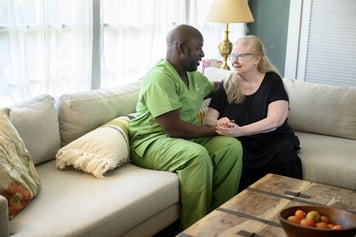A face-to-face encounter is necessary for certifying the patient’s eligibility for home health services. Certifying providers or inpatient facility (acute/post-acute care) medical records are used as the basis to determine the patient’s eligibility for the Medicare home health benefit.
Before having the conversation, ensure you understand the qualifiers, timing, home health documentation and best practices for a successful conversation.
Does Medicare Require a Face-to-Face Visit?
Yes – to complete a referral to a Medicare-certified home health agency, healthcare providers must have a face-to-face visit with patients certifying the need for home health services. This documented encounter helps confirm the patient’s home health eligibility requirements.
[action 1]
When to Perform the Face-to-Face Visit
As part of the Affordable Care Act, home health care patients must have a face-to-face (FTF) visit with the certifying physician within 90 days prior to, or within 30 days after, the start of home health care services. This visit with the patient must be related to the reason for the admission to home health services.
Who Is Authorized to Perform the FTF Encounter Visit?
CMS guidelines state the FTF Encounter Visit can be performed by the following:
- Certifying Provider: (A physician, non-physician practitioner*) This provider is responsible for certifying the patient for home health services and that the FTF Encounter has occurred.
- Facility Provider (Acute or Post Acute): A physician/non-physician practitioner who cared for the patient directly prior to the admission to home care services.
- Qualified non-physician practitioner working:
- In collaboration with an acute or post-acute physician in the facility, or,
- Under the supervision of the certifying physician.
*Non-Physician practitioner is defined as a nurse practitioner, physician assistant, certified midwife or clinical nurse specialist.
Home Health Documentation Requirements
The certifying physician’s medical records or the acute or post-acute care facility’s medical records (if the patient was directly admitted to home health) are used to determine the patient’s eligibility for the Medicare home health benefit. Upon request, you must provide this documentation to the home health agency, review entities or Centers for Medicare and Medicaid Services (CMS).
These medical records must include sufficient documentation to justify the referral to home health services, including a need for skilled services and homebound status:
- Intermittent skilled services: Skilled services include skilled nursing, physical therapy, speech therapy or occupational therapy.
- Homebound status: The patient is generally confined or medically restricted to their residence but can leave for home absences that are infrequent and short in duration.
The medical records must also include the actual clinical note for the FTF conversation, demonstrating that the encounter:
- Was related to the primary reason for home health services.
- Was performed by an allowed provider type.
- Occurred within the required timeframe.
In addition to the patient’s clinical condition, homebound status and need for skilled services, it’s important that the FTF documentation also include the patient’s name, date of visit and physician’s signature and date.
Tips for Communicating with Patients
Empathetic communication can encourage your patients when life feels uncertain. They may be dealing with complex emotions surrounding change. See this conversation as an opportunity to strengthen your relationship, improve their health and help them feel at ease.
Actively listen to your patient.
Be mindful that you’re facilitating the conversation. As much as you inform your patient about home health care, you must also listen to and empathize with their concerns. Home health is likely unfamiliar and potentially a major change.
Build trust with transparency and honest intentions.
If your patient is unfamiliar with home health care, educate them on their options. Emphasizing the benefits can address any concerns your patient might have.
If you hear them refer to any myths or misconceptions about home health care, be ready to relay accurate information about home health care. You might be surprised that some patients don’t know that hospice and home health are different types of care.
Include caregivers.
If your patient has family members, friends or medical assistants who act as caregivers, invite them to join the FTF conversation. These caregivers are part of the healthcare team and help your patient feel more at ease and even reinforce the information you provide. Offer the patient the ability to speak with a representative from your home health provider of choice to review the benefits in greater detail.
Let’s Help Your Patients Together
Amedisys home health care can help you save time in your office, stay better informed about your patients and avoid unnecessary hospitalizations. Recognizing that no two patients are the same, we meet your patients and their families where they are while partnering with you to support them in their home health journey.






